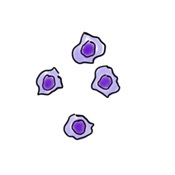What’s the CBC?
A CBC, or Complete Blood Cell Count, is a common test we run at the veterinary clinic! We look at a small drop of blood under the microscope and count the types of cells we see. Running a CBC can help the veterinarian diagnose a wide range of conditions, from anemia to infection, and is very important for assessing our animals!
Below is a short glossary (list) of some of the cells we might find with a CBC:
Red Blood Cells and Platelets: These are the most common cells in the blood.
1) Red Blood Cell: This is the most important cell in the blood! Red blood cells pick up oxygen in the lungs and carry it around the body. If our pets do not have enough red blood cells we say they are anemic.
2) Schistocyte: This is a damaged red blood cell.
3) Spherocyte: This is a red blood cell that has been attacked by the immune system. Eek!
4) Platelet: These tiny cells help blood clot. When you get a cut and it stops bleeding, thank your platelets!
White Blood Cells: These are the immune system cells; they help keep the body safe from bacteria, viruses, and more!
5) Neutrophil: This is a very common white blood cell. Neutrophils do many things, but the most important thing they do is kill bacteria!
6) Eosinophil: This white blood cell is involved in killing parasites, but also plays a role in allergies!
7) Monocyte: A monocyte’s primary job is to clean up germs and debris, like the garbage truck of the body. When monocytes leave the blood stream they are called macrophages.
8) Lymphocyte: There are many types of lymphocytes, including B, T, and NK cells. These perform a wide range of jobs, including attacking infections and infected cells.
9) Basophil: This large white blood cells is involved in allergic reactions and inflammation.
Parasites: Sometimes we diagnose a parasite because we see it lurking among the blood cells!
10) Microfilaria: This is an immature (young) heartworm. Heartworm is a disease dogs can get from mosquitoes!









